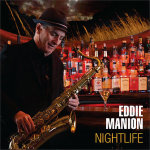 OK, so just to save a bit of time, we all know about Eddie Manion, yeah? Whaddya mean, no? Where have you been for the last forty years? You really should get out more. If you want the whole nine yards, check out his Wikipedia entry, but, just for the moment, his first major gig was with Southside Johnny and the Asbury Jukes, and since then he’s played with Dion, Dave Edmunds, Diana Ross, The Allman Brothers, Willy De Ville, Keith Richards and Bob Dylan and many, many more. He was part of the E Street Band for Bruce Springsteen’s “Wrecking Ball” tour and, more recently, he’s been touring Europe with the Light of Day Foundation raising money for Parkinson’s Disease research. His motto is ‘Have Sax, Will Travel’.
OK, so just to save a bit of time, we all know about Eddie Manion, yeah? Whaddya mean, no? Where have you been for the last forty years? You really should get out more. If you want the whole nine yards, check out his Wikipedia entry, but, just for the moment, his first major gig was with Southside Johnny and the Asbury Jukes, and since then he’s played with Dion, Dave Edmunds, Diana Ross, The Allman Brothers, Willy De Ville, Keith Richards and Bob Dylan and many, many more. He was part of the E Street Band for Bruce Springsteen’s “Wrecking Ball” tour and, more recently, he’s been touring Europe with the Light of Day Foundation raising money for Parkinson’s Disease research. His motto is ‘Have Sax, Will Travel’.
Eddie Manion plays tenor and baritone sax (mainly baritone when working as part of a horn section) as well as having a pretty good voice, which you can hear on his first solo album, “Follow Through”, released in 2004. At the end of the gargantuan “Wrecking Ball” tour, Eddie started work on his second solo album “Nightlife”, opting this time for instrumental interpretations of standards and not-quite-so-standards, rather than his own compositions. It’s a double-edged sword. Both ways you’re going to be judged; one way you’re compared with others’ songwriting, the other way you’re compared with previous versions of the same songs. So how does “Nightlife” shape up?
I guess it’s natural for anyone who’s spent their entire adult life as a professional musician to want to do their own thing once in a while. Eddie Manion’s spent a lot of time playing in horn sections in big bands where nuance isn’t always too high on the agenda, so when the window of opportunity opened, he pulled together a superb bunch of musicians to make an album placing his sax playing firmly stage centre against a backdrop that allows him to interpret songs with style and subtlety. From the album’s opener, a gorgeous version of the theme from the 1961 movie “Town Without Pity”, with its piano triplets and wah-wah trumpet, to the closer “”The Only One, from Roy Orbison’s final album, the album demonstrates Eddie’s ability to create flawless interpretations of jazz standards such as “Smoke Gets in Your Eyes” and “Stardust” whilst also combining Springsteen’s “City of Night” in a medley with King Curtis’s “Soul Serenade”.
Throughout “Nightlife”, Eddie Manion combines a jazz-styled finesse with a rawer rock edge to create a satisfying and varied set of instrumentals that embody great musicianship and sympathetic arrangements. If you value musical skill and the ability to pick a good tune, then you’ll love this; Eddie’s a superb player and he’s surrounded himself with like minds to produce a real musician’s album. As an added bonus, Eddie’s also a very good photographer and the CD packaging includes some of his own fabulous photos taken mainly on the “Wrecking Ball” tour; it’s the icing on the cake of a lovely album.
You can order it here.
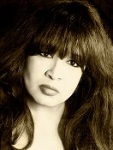 There’s a couple of interesting tours coming up in late November/early December that we really thought we should share with you. First up is a tour by the absolute legend Ronnie Spector with her “Ronnie Spector Sings the Fabulous Ronettes” tour, featuring the greatest Ronettes hits, including “Me My Baby”, “Baby I Love You”, “Do I Love You” and “Wallking in the Rain”, plus Jeff Barry/Ellie Greenwich/Phil Spector originals that became hits as covers, such as “I Can Hear Music” (Beach Boys) and “Chapel of Love” (Dixie Cups). The tour follows the release earlier this month of “The Very Best of Ronnie Spector” on Sony Music.
There’s a couple of interesting tours coming up in late November/early December that we really thought we should share with you. First up is a tour by the absolute legend Ronnie Spector with her “Ronnie Spector Sings the Fabulous Ronettes” tour, featuring the greatest Ronettes hits, including “Me My Baby”, “Baby I Love You”, “Do I Love You” and “Wallking in the Rain”, plus Jeff Barry/Ellie Greenwich/Phil Spector originals that became hits as covers, such as “I Can Hear Music” (Beach Boys) and “Chapel of Love” (Dixie Cups). The tour follows the release earlier this month of “The Very Best of Ronnie Spector” on Sony Music.
As if that wasn’t enough, Ronnie’s also working on her new album “English Heart”, a set of covers of songs by the sixties British invasion bands including The Beatles, The Stones, Gerry and the Pacemakers and The Animals which is scheduled for release in April 2016 on 429 Records. If you want to see the greatest hits tour, Ronnie’s doing the following dates:
November 28 Philharmonic Hall Liverpool
November 29 Royal Concert Hall Glasgow
November 30 The Sage Gateshead
December 1 Town Hall Birmingham
December 3 The Barbican London
December 4 Colston Hall Bristol
In early December, the European leg of the Light of Day tour comes to the UK. The Light of Day Foundation is a charity raising funds for research into Parkinson’s and related degenerative diseases, which originated in New Jersey in November 2000 and has been supported by many performers including Bruce Springsteen (whose song gave the Foundation its name), Michael J Fox, Southside Johnny, Darlene Love, Willie Nile, Jakob Dylan, Lucinda Williams, Badly Drawn Boy and Gary ‘US’ Bonds.
The headline band for the UK tour this year is Joe D’Urso, Vini ‘Mad Dog’ Lopez, Eric Bazilian, Ed Manion and Jake Clemons. If you want to see some incredible musicians and donate some cash to a very good cause, then you can catch the Light of Day tour on the following four UK dates:
December 4 Oran Mor Glasgow
December 5 TAPE Arts Centre Colwyn Bay
December 6 The Musician Leicester
December 8 The Half Moon, Putney London
You should catch both of these tours if you can, and maybe we’ll see you at The Half Moon for the Light of Day gig.
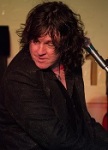 We’re big fans of Bob Malone here at MusicRiot so when I got the chance to meet up for a chat on the final night of his UK tour it was a bit of a no-brainer. Bob’s been in the UK for three weeks touring in support of his “Mojo Deluxe” album and the “Mojo Live” DVD and The 100 Club gig was the climax of a hectic tour schedule. So a very noisy 100 Club dressing room is where we got the chance to talk about old pianos, New Orleans and Southside Johnny, among other things:
We’re big fans of Bob Malone here at MusicRiot so when I got the chance to meet up for a chat on the final night of his UK tour it was a bit of a no-brainer. Bob’s been in the UK for three weeks touring in support of his “Mojo Deluxe” album and the “Mojo Live” DVD and The 100 Club gig was the climax of a hectic tour schedule. So a very noisy 100 Club dressing room is where we got the chance to talk about old pianos, New Orleans and Southside Johnny, among other things:
Allan – So it’s approaching the end of the tour and we met on the first night in Southend. How has it been since then?
Bob – It’s been great; a few funky gigs, a few spectacular gigs and we’ve worked hard. We had a couple of nights where we didn’t have gigs but we still had a radio show or a long drive; we’re a hard-working group.
Allan –Have you had any particularly good gigs?
Bob – This one’s definitely gonna be a good one and Keighley Blues Club, that was a really great crowd and Scotland as well, and we also played on the Isle of Wight.
Allan – I remember when we met in Southend you were talking about Italian audiences.
Bob – They’re full on, right out of the box, from the first song.
Allan –Do you notice any differences in the audiences around the UK?
Bob – Well it sometimes takes three or four songs here. The north is different from the south, as you know. I didn’t until I did these long tours here; England was just England like people think America is just America but here it’s five different countries with completely different cultures.
Allan – Have you played The 100 Club before?
Bob – No, but its reputation precedes…
Allan – How does that feel?
Bob – It feels good. I was soundchecking with the grand piano earlier and the sound engineer had footage of Paul McCartney playing that same piano.
Allan – I think it’s great to see it with the lights up and look at all those great photos around the walls of the people that have played here in the past.
Bob – I love places with history like this; you feel like you’re part of a continuum.
Allan – You’re promoting the Mojo Deluxe album at the moment. What kind of a reception has the album had?
Bob – I think it’s the most press and radio I’ve had on anything I’ve done and it’s my twentieth year of making records, so I’m happy with that.
Allan – After doing what I think of as the day job with John Fogerty, how does this compare? It must be a huge culture change.
Bob – It’s different. I’ve been doing this for twenty-five years; this is what I do, and I’ve been playing with John for almost five years now. With this, so long as the sound man is competent I’m happy. Everyone thinks it must be weird to go from small crowds to big crowds, but it really isn’t. As long as it’s a good musical experience and you’re connecting with an audience; that’s why we play. You can’t really control the size of the crowd and also when I do this it’s a mission; when I play with John it’s his gig. I’m lucky to be there but it’s his gig. I get my solo but other than that, it’s all about him and I’m just in the background.
Allan – Trying to avoid the pyrotechnics…
Bob – Trying not to burst into flames during “Fortunate Son”, exactly.
Allan – So when you’re out doing your own stuff, here and in the States, what would be your ideal band line-up?
Bob – The ultimate, when I’m not touring; when I’m LA, and I don’t have to put people in hotel rooms would be a nine-piece band. I just did a DVD, which I did the way I would like to do it and I had three female background singers, percussionist, drums, bass and guitar. I do a lot of stuff with horns as well, for years I had a horn section, so it would be a nine to eleven piece band and a second keyboard player would be great, to play the organ parts. (If you’re really paying attention, you’ll notice that the total number of musicians is only eight, but there’s a slide guitar player on there as well. I hope your heart isn’t broken by that omission Marty Rifkin.)
Allan – On your own tours, particularly in the UK, you rely on the venue providing the piano. Have you had any horror stories with that in the past?
Bob – Well, usually I carry a digital piano for when there’s no real alternative, but most of the places I play now, if there is a real piano, it’s usually in good shape, but I’ve been to places that had a hundred year old upright and some of the keys didn’t work but I kind of like to play those anyway, just for the challenge. It’s like going in the ring with this old piano and fighting it to see who wins. I love real pianos because they all have personality; the digital ones are handy and they’re light and they don’t go out of tune, but they don’t have much of a personality. They get the job done.
The one in Southend, that’s got some issues. It’s got some broken strings; it’s one that I fight to the death but I like playing it because it’s an old Bösendorfer.
Allan – I did notice a few problems at the soundcheck that night…
Bob – It needs a rebuild, but still I’m glad to see it.
Allan – You’re classically and jazz trained; was there any one thing that turned you into a rock/blues pianist?
Bob – The rock thing came first. One of those things was hearing “Sergeant Pepper” for the first time, so it’s you guys, it’s your fault. Then I heard Billy Joel and Elton John and not very long after that the New Orleans thing, which blew me away, and then Ray Charles and I became a huge student of that stuff but the rock stuff was always there.
Allan – Were you singing right from the start?
Bob – I started singing when I was fifteen probably. I started singing because I wanted to impress a girl I had a crush on. I just played classical piano but “Your Song” by Elton John was the first thing I ever sang in public; I thought ‘She’ll love me if I sing this song’. I was a terrible singer, some people still say I am, but I learned to work with what I have.
You write songs and there are obviously lots of people with better voices than me but when you write songs you have a story to tell and people always respond to the story and sometimes you’re the only person that can tell it.
Allan – We’ve had “Mojo Deluxe” this year, so what’s next on the agenda.
Bob – Well, I’ve got this DVD coming out and the audio from that was so good, we’re thinking of putting that out as a live record next year and I’ll make another new record, so I’ll probably get the live one out next year and in 2017 I’ll have a new studio album. I’ve got to get realistic about this; I’ve got about half the songs I need for another record.
Allan – I interviewed Southside Johnny in July 2014 in London…
Bob – Southside Johnny was also one of the big things in my youth and I should mention this because growing up in New Jersey, we all knew Southside Johnny. This was the 80s and you couldn’t hear that kind of music on the radio at all and so my first real exposure to r’n’b, blues, horn section kinda music was Southside and I learned from that and went back and figured out all the other stuff. He was huge for me.
Allan – When I interviewed him at Shepherds Bush Empire last July, we spoke about his new album “Soultime!” and he said they were aiming to get it out for Christmas 2014 and that finally came out in August this year.
Bob – Yeah, that’s about right. I toured here last year and I had half of “Mojo Deluxe” out as “Mojo EP”. We had finished recording and it was half-mixed and there were some problems and we couldn’t get the other half mixed in time and the promoter said ‘The whole thing is you have a record out for this tour; we can’t get any press without a record’ so we had half a record out as an EP, just in the UK for the tour.
Allan – And that worked really well as a sampler for the album.
Bob – And by the end of last year the whole thing was done but then we needed a three month ramp for the release date to get it publicised and I was touring through the spring, so we just put the whole thing off and it came out almost a year later. That’s how it works. There are so many factors; if you have a lot of money involved, you can get things done a lot quicker. On a limited budget, you still need time to publicise, so you often end up delaying.
Allan – One final question; do you have one song that tears you up and gets you really emotional?
Bob – Yeah, “One for my Baby”, the Sinatra song; that one kills me every time. It depends on the day; it could be something else on another day.
Allan – Thanks very much, Bob.
And there you go; a private audience with the great Bob Malone, who was as entertaining offstage as on. Since we spoke, I’ve had a chance to watch the “Mojo Live” DVD and it’s superb, capturing the magic of a one-off performance absolutely perfectly. It has great performances from all of the musicians and it’s a whole load of fun; keep an eye out for it.
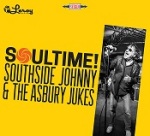 If you’re looking for something that’s easy on the ear to use as aural wallpaper for your commute or as background music for a dinner party, then stop right here; this is proper music. Southside Johnny has been making music with various Asbury Jukes for over forty years and compromise isn’t something that he’s about to start now. The quality of the songs, the playing and the arrangements is what it’s all about; always has been, always will be. Southside had fraught relationships with his various labels in the days when bands signed to a label and hoped that the label would make them successful but it hasn’t worked that way for a while now so Southside has moved on to a completely different way of working; he has control over the creative and business processes. ‘When’s the album being released? When it’s ready’. And “Soultime!” is well and truly ready. It’s taken a while (the last album “Pills and Ammo” was released in 2010), but Southside’s a very busy man these days; not only is he trying to keep an eight-piece rock and soul band in line, but he’s also working with his Americana project The Poor Fools, comprising various Jukes and some of the extended Jersey shore family.
If you’re looking for something that’s easy on the ear to use as aural wallpaper for your commute or as background music for a dinner party, then stop right here; this is proper music. Southside Johnny has been making music with various Asbury Jukes for over forty years and compromise isn’t something that he’s about to start now. The quality of the songs, the playing and the arrangements is what it’s all about; always has been, always will be. Southside had fraught relationships with his various labels in the days when bands signed to a label and hoped that the label would make them successful but it hasn’t worked that way for a while now so Southside has moved on to a completely different way of working; he has control over the creative and business processes. ‘When’s the album being released? When it’s ready’. And “Soultime!” is well and truly ready. It’s taken a while (the last album “Pills and Ammo” was released in 2010), but Southside’s a very busy man these days; not only is he trying to keep an eight-piece rock and soul band in line, but he’s also working with his Americana project The Poor Fools, comprising various Jukes and some of the extended Jersey shore family.
Through the various incarnations of The Jukes, Southside has always had a collaborator helping with songwriting and musical director duties; Steve van Zandt moved on to the E Street Band as Springsteen went up through the gears and Bobby Bandiera took on the ‘safe pair of hands’ role with Bon Jovi on his seemingly endless world tour. Which, after an overlap with Bobby, left Jeff Kazee, keyboard virtuoso with a great high tenor soul voice, as the partner in crime. And, as much as I love the work of Little Steven and Bobby Bandiera, the Jeff and Johnny combination is producing some stunning results as Southside takes more credit for his songwriting contributions and Jeff Kazee adds his voice to the mix as well; it’s a potent combination.
In 2001, Southside released “Messin’ with the Blues”, an album of songs illustrating his love of blues, but also demonstrating the variety of styles within blues music; fourteen years later, “Soultime!” applies the same template to a cross-section of soul styles. It’s not too difficult to identify the influences, but the quality of the writing and the performances ensure that this is an album to be judged on its own merits.
The opening track “Spinning” throws all the ingredients into the blender to create a manic Stax feel. Everything’s there, from the horn fills to the breakdown, building back up with John Conte’s bass, Jeff Kazee’s Hammond and Glenn Alexander’s guitar, to the call and response vocal and the big horn finish. There’s barely time to get your breath back before “All I Can Do” the mid-tempo Johnny/Jeff duet. The two voices combine perfectly and a sweet tenor sax solo from John Isley is the icing on the cake. “Don’t Waste my Time” could be early Jukes, musically and lyrically as Southside tells the ‘my girl done me wrong’ story supported by backing vocalists Elaine Caswell, Layonne Holmes and Catherine Russell before Neal Pawley steps up for a trombone solo.
“Looking for a Good Time” is the album’s defining song. The inspiration for the album came from hearing “Superfly” in the booze aisle at the supermarket and watching how the shoppers reacted. “Looking…” captures the upful mood of Curtis Mayfield in 1970 perfectly; if anything ever made me wish I could dance, this is it. The namechecks in the lyrics say it all, really: ‘Isley Brothers and Curtis and Sly and Bobby Womack too’; it’s perfect. “Words Fail Me” is a mature love ballad with very tasteful backing (even drummer Tom Seguso is reined in), muted horns and a lovely flugelhorn solo from Chris Anderson; Johnny’s voice is sublime and it would melt a heart of stone. “Walking on a Thin Line” has a faintly menacing Latin feel evoking Isaac Hayes, The Temptations and The O’Jays but still totally Jukes.
What comes next is a very rare thing indeed; an instrumental on a Jukes album. “Klank” is the love child of “Soul Finger” and “Third Stone from the Sun” with harmonica and tenor sax solos; they’re allowed to have fun as well, you know. Carrying on with the levity, “Ain’t Nobody’s Bizness” is a bit of light-hearted fun with a cast of Damon Runyon characters and a nod to “Check Mr Popeye” from way back when, which takes the intensity down a little bit before the final three songs.
“I’m Not That Lonely” totally nails the Motown sound (Four Tops, anyone?) while “The Heart Always Knows” harks back to a much earlier time (Sam Cooke, or maybe The Cascades). It’s a slow, gentle ballad with some nice pizzicato strings courtesy of Jeff Kazee and acoustic guitar from Glenn Alexander and it takes off the heat for a few minutes before the final offering. “Reality” takes its influence from the psychedelic soul of the late sixties/early seventies with some interesting synth sounds and John Isley’s flute (and is that bass sax on there as well?), strings and muted horns; it gets kinda busy in there at times.
Southside Johnny set out to evoke a certain era of soul with this album; he wanted to make us feel good, the way we did when we first heard all of the great artists who influenced this album, and it’s an unqualified success. The arrangements perfectly capture the feel without sounding like The Faux Tops; he and The Jukes have created a perfect homage to music that was the soundtrack to the sixties and seventies. Over forty years down the line, he still has that raw, emotive voice that cuts through Hammond and horns and straight to the heart. Working with Jeff Kazee and the latest incarnation of The Jukes, he’s turned out a modern soul classic.
“Soultime!” is released on September 1 on Leroy Records.
Part One
It’s unbelievable, really. We’re already halfway through 2015; how did that happen? Well, however it happened, there’s been an awful lot of it. At the start of the year, we made a few predictions about bands and artists to keep an eye on in 2015 and this seems like a pretty good time to have a look at how they’re getting on and maybe add a few more to the mix. So why don’t we start at the beginning because, apparently, that’s a very good place to start.
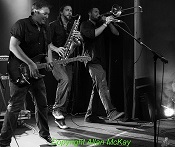 The first of our hot picks to shake some action in 2015 was the Billy Walton Band with “Wish for what You Want”, their first release on American independent label Vizztone in February 2015 after a series of self-released albums. We’ve been watching Billy Walton live since 2010 and he’s been steadily edging up the rankings. The band’s increased in size as well, from a power trio to a six-piece on the latest UK tour and the addition of sax, trombone and keyboards has emphasised their awesome live power while allowing them to move in new directions. Like his fellow New Jersey artists Springsteen and Southside Johnny (Billy has toured as an Asbury Juke in the UK a couple of times), Billy’s fond of taking the show in unexpected directions and these guys are easily good enough to follow him. They should be back in the UK later in the year, so watch out for them in your area.
The first of our hot picks to shake some action in 2015 was the Billy Walton Band with “Wish for what You Want”, their first release on American independent label Vizztone in February 2015 after a series of self-released albums. We’ve been watching Billy Walton live since 2010 and he’s been steadily edging up the rankings. The band’s increased in size as well, from a power trio to a six-piece on the latest UK tour and the addition of sax, trombone and keyboards has emphasised their awesome live power while allowing them to move in new directions. Like his fellow New Jersey artists Springsteen and Southside Johnny (Billy has toured as an Asbury Juke in the UK a couple of times), Billy’s fond of taking the show in unexpected directions and these guys are easily good enough to follow him. They should be back in the UK later in the year, so watch out for them in your area.
 Dean Owens is another artist the Riot Squad has been following for some time; well since the release of his 2012 album “New York Hummingbird” anyway. Dean has deservedly been acclaimed by those in the know (including Irvine Welsh) for some time now as a singer/songwriter but hasn’t ever managed to get the wider attention he really deserves; it looks like his 2015 album “Into the Sea” on Drumfire Records may have changed that. It’s generated a huge amount of media attention including a Bob Harris interview and live session for Radio 2 and an appearance on the cult BBC Radio Scotland football show “Off the Ball” presented by Stuart Cosgrove and Tam Cowan. The album’s probably his best yet with some highly personal lyrics and memorable melodies backed up by a great group of Nashville musicians.
Dean Owens is another artist the Riot Squad has been following for some time; well since the release of his 2012 album “New York Hummingbird” anyway. Dean has deservedly been acclaimed by those in the know (including Irvine Welsh) for some time now as a singer/songwriter but hasn’t ever managed to get the wider attention he really deserves; it looks like his 2015 album “Into the Sea” on Drumfire Records may have changed that. It’s generated a huge amount of media attention including a Bob Harris interview and live session for Radio 2 and an appearance on the cult BBC Radio Scotland football show “Off the Ball” presented by Stuart Cosgrove and Tam Cowan. The album’s probably his best yet with some highly personal lyrics and memorable melodies backed up by a great group of Nashville musicians.
 Next up was The Kennedys; Maura and Pete Kennedy are also from the East coast of the USA; New York City is their adopted home. They decided to celebrate their twentieth anniversary by releasing not one, not two, but three albums this year and to tour in support of the albums. Two of the albums have already been released, The Kennedys album “West” and Maura’s solo album (with lyrics from poet B.D. Love), “Villanelle” and they’re both exceptionally beautiful pieces of work. Still to come (in September) is Pete’s long-awaited solo piece “Heart of Gotham” a suite of songs inspired by New York City and its inhabitants. Pete’s poetic sensibilities, huge knowledge of the history of American music and quiet mastery of his instrument (or more accurately, instruments) make this another one to look out for.
Next up was The Kennedys; Maura and Pete Kennedy are also from the East coast of the USA; New York City is their adopted home. They decided to celebrate their twentieth anniversary by releasing not one, not two, but three albums this year and to tour in support of the albums. Two of the albums have already been released, The Kennedys album “West” and Maura’s solo album (with lyrics from poet B.D. Love), “Villanelle” and they’re both exceptionally beautiful pieces of work. Still to come (in September) is Pete’s long-awaited solo piece “Heart of Gotham” a suite of songs inspired by New York City and its inhabitants. Pete’s poetic sensibilities, huge knowledge of the history of American music and quiet mastery of his instrument (or more accurately, instruments) make this another one to look out for.
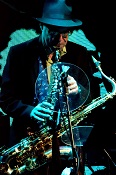 Well that’s the story so far, but there’s more to come later in the year. Stone Foundation were obviously on the way up in 2014 when we reviewed their album “To Find the Spirit”, but 2015 has seen them providing the title track for the wonderful short film “Beverley”, trekking across Europe, signing record deals in Japan and the USA and recording the superb “A Life Unlimited” album which is released in the UK on August 7 this year. There’s a UK tour to promote the album, followed by a Japanese tour and some festival appearances over the summer. Pre-sales on the album have been very impressive and this looks like the year that Stone Foundation finally become an overnight success. Keeping the faith seems to finally be paying dividends.
Well that’s the story so far, but there’s more to come later in the year. Stone Foundation were obviously on the way up in 2014 when we reviewed their album “To Find the Spirit”, but 2015 has seen them providing the title track for the wonderful short film “Beverley”, trekking across Europe, signing record deals in Japan and the USA and recording the superb “A Life Unlimited” album which is released in the UK on August 7 this year. There’s a UK tour to promote the album, followed by a Japanese tour and some festival appearances over the summer. Pre-sales on the album have been very impressive and this looks like the year that Stone Foundation finally become an overnight success. Keeping the faith seems to finally be paying dividends.
Part Two coming soon…
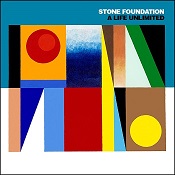 It’s always a good feeling when a band or artist you like starts to get a bit of recognition, particularly when you know they’ve put in the hard hours over a long period of time and they’re doing something that they believe in and they’re committed to body and soul. In 2014, things were finally starting to happen for Stone Foundation. After years of serious graft with no industry backing, playing support slots, organising their own tours and self-funding their releases, people started to take notice and they got a bit of radio exposure (Craig Charles helped a bit there). They did support tours with The Selecter and The Blow Monkeys and the album “To Find the Spirit” made a dent in the independent charts; even The Modfather was photographed holding a copy. So, where to next?
It’s always a good feeling when a band or artist you like starts to get a bit of recognition, particularly when you know they’ve put in the hard hours over a long period of time and they’re doing something that they believe in and they’re committed to body and soul. In 2014, things were finally starting to happen for Stone Foundation. After years of serious graft with no industry backing, playing support slots, organising their own tours and self-funding their releases, people started to take notice and they got a bit of radio exposure (Craig Charles helped a bit there). They did support tours with The Selecter and The Blow Monkeys and the album “To Find the Spirit” made a dent in the independent charts; even The Modfather was photographed holding a copy. So, where to next?
Well, the next album, “A Life Unlimited”, is out on August 7th, so that’s a pretty good place to start. It would have been so easy to stick with the style that made “To Find the Spirit” successful, but that’s not what these guys do; the new album was always going to move in a slightly different direction, particularly after a few of the personnel changes that are almost inevitable in a large group.
The opening song, “Beverley”, (the theme tune from Alexander Thomas’ short film of the same name) is a tantalising hint as to the slight change of direction. It could almost be a track from the previous album, apart from the congas (courtesy of new member Rob Newton), which infuse a little Latin spirit into the funky cocktail of horns, Hammond and wah-wah guitars. There’s a change of emphasis in the brass section as well; Gareth John filled the trumpet vacancy last year and Adam Stevens has come in on baritone sax to replace trombonist Spencer Hague while he takes a break, both joining long-standing tenor saxophonist Gary Rollins. It gives the brass section a more Stax/Atlantic feel with a greater focus on ensemble playing as opposed to solos. It’s a philosophy which applies to the band generally; Stone Foundation is about eight guys working together to create gorgeous grooves and it works because the egos are reined in and the band is more important than the individual.
The sumptuous ballad “Pushing Your Love”, with harmonies from The Four Perfections, wouldn’t have sounded out of place on the previous album, while “Something in the Light” takes a little step forward with the brass section, particularly Adam Stevens’ baritone lines, generating a Memphis Horns feel and the Q Strings adding a touch of velvet to the sting of brass. And that’s all before the Van Morrison-style breakdown with strings, tenor sax and backing vocals from The Four Perfections and Janet and Samantha Harris. Lovely stuff.
“The Turnaround” and “Learning the Hard Way” are real departures for the band. The horn fills have a New York/Cuban feel which weave around Neil Sheasby’s bubbling bass lines and Neil Jones’ guitar to create a sound which is much more New York fusion than small town soul; the kind of thing Southside Johnny and his brass section The New York Horns have been doing so well recently. They’re both irresistibly funky.
It’s the two centre pieces (or the last track on side one and the first on side two if you’re going for the vinyl) which give the clearest indication of the new influences on this album; there’s a bit of jazz in the mix. “Speak Your Piece” is a sprawling epic of a song which starts with handclaps, a piano motif (which is picked up later by the horns) and a five-note bass riff which runs through the song. Even as the song builds and layers are added, there’s always plenty of space in the mix; it never feels crowded as it builds up to a noisy chorus and drops back to piano and bass under the lead before building up again to big horn-driven finale. There’s even a one-note piano solo from Ian Arnold, and if that isn’t jazz, I don’t know what is. “The Night Teller” has a mid-tempo cool jazz feel evoking the cover artwork of Donald Fagen’s classic “The Nightfly” album and features a guest vocal by Graham Parker underpinned by some understated baritone sax. It’s all beautifully played and GP’s vocal works perfectly as a complement to the voice of Neil Jones. “These Life Stories” is a mid-tempo groove built around some laconic brass ensemble playing and delicate electric piano and it’s another example of the ‘less is more’ philosophy; you don’t need flash when a band can play this well together. Even the conga solo is politely restrained.
“A Love Uprising”, the album’s penultimate track, opens up like a 1990 house tune with a simple piano riff and Philip Ford’s four-to-floor kick drum but, within a few bars congas come in to soften the beat before seventies hi-hats and funk guitar, and then brass fills morph the piece into classic New York disco. And who’s that coming in just before two minutes with a rap? It’s Dr Robert from The Blow Monkeys making a guest appearance. Just to add to the Studio 54 ambience, you even get congas and disco whistles; it’s so authentic they knocked back Nile Rodgers when he tried to get in to the session. The closing track “Old Partners, New Dances” is an instrumental piece featuring Ian Arnold on piano and Gareth John on flugel horn, evoking the feel of a jazz club at four in the morning and it’s perfect way to bring the album down for a soft landing after the manic buzz of “A Love Uprising”.
Since the sessions for “A Life Unlimited”, the band has signed record deals in Japan (with P-Vine Records) and the USA (with Spectra Music Group); things definitely aren’t standing still at the moment and, with this album, they probably have the right set of songs to break through. What shines through every aspect of the album is quality; the songs are well-crafted, the arrangements are sensitive and varied and the performances are all superb. Even the artwork by Horace Panter (you are going to buy it on CD or vinyl, aren’t you?) is spot on. Maybe “A Life Unlimited” proves that, in a world where a Glastonbury headliner gets away with out-of-tune karaoke, there’s still room for music created with passion and talent.
“A Life Unlimited” is released on August 7/ 2015.
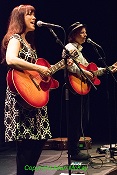 Just before the end of their recent twentieth anniversary tour of the UK, I was lucky enough to chat to Pete and Maura Kennedy at Kings Place in London just after their soundcheck. We talked about how they met, songwriting, technology and a whole lot more. Here’s how it went:
Just before the end of their recent twentieth anniversary tour of the UK, I was lucky enough to chat to Pete and Maura Kennedy at Kings Place in London just after their soundcheck. We talked about how they met, songwriting, technology and a whole lot more. Here’s how it went:
Allan – So, twenty years together this year. I’ve heard the story but I’m sure Music Riot readers will love it. Could you tell them the story of how you met?
Pete – Well, that happened down in Austin, Texas and we always say that the only trouble with Austin is that it’s surrounded by the rest of Texas, because it’s very much a college town and not typical of the American South at all but it’s a very rock ‘n’ roll and folk and songwriter-oriented town. There’s a place called The Continental Club which is the roots music Mecca of America; I was doing a gig there and that’s where the two of us met. First we talked about music, we didn’t actually play or sing and we then met up a day later at a little songwriters gathering and when we did sing together we found out that we loved each other’s songs and we had a bit of a harmony blend and so we started writing but I had to leave right away and play with Nanci Griffith up at Telluride, Colorado. I drove up there through the desert and into The Rockies and I called Maura after the show and we really wanted to get back together. We were talking on the phone and we decided that since we both knew that we loved Buddy Holly, we would meet at the equidistant point between Austin, Texas and Telluride, Colorado and it was Lubbock, Texas which is where Buddy Holly’s from and he’s buried there. We each drove five hundred miles solo with no cellphones, so we didn’t really know that the other person was doing this and we met at Buddy Holly’s grave and we’ve really been together ever since because very shortly after that, Nanci Griffith needed another band member, a female singer to do harmonies and Maura stepped right into that role and so we’ve been working together steadily ever since we first met.
Maura – And when we left for that tour, we were both in her band but, at the airport, she told us we were going to be her support act for that tour, back in 1993, and we’d only written that one song, we didn’t have an act worked up but we didn’t tell her any of this because we didn’t want to blow that opportunity so we bluffed our way through the first couple of gigs.
Pete – The Southport Theatre was the first gig.
Maura – And by the end of the tour we had our first album’s worth of songs.
Allan – That is a great story.
Pete – We always acknowledge Buddy Holly as our patron saint…
Maura – And Nanci Griffith as the bird that pushed the little chickadees out of the nest.
Pete – She was our mentor: no doubt.
Allan – The first time I saw you was actually in this venue two years ago and that year you had one album out, last year between you, you had two albums out, this year it’s three albums. By anyone’s standards that’s pretty good going, so what can you tell me about the three albums?
Maura – For some reason, both of us were on a real writing spree over the last six to eight months and we were both writing together, both writing independently and gathering songs and it was apparent that we had more songs than we needed for one album, but it also looked pretty obvious how the songs would divide up. The songs we were writing together would be on The Kennedys album, which is called “West”, and that came out last month. Then I was working with a published poet out in California; he provided me with all these lyrics that he wrote specifically for me to write music to and these had a different quality so we decided to have all those solo songs on my album “Villanelle”, which is coming out next week. Meanwhile Pete has been working on this, I think it’s his masterpiece, he’s been working on these songs a good five years. It’s a cycle of songs set in New York City and he sings on these. People are used to him releasing instrumental albums but this is a really cool rock ‘n’ roll album and it’s called “The Heart of Gotham” and that’s coming out in June. So rather than take the twentieth anniversary as a moment to look back we charged straight ahead.
Allan – So apart from having three albums of new material, over the years, how do you keep the live shows fresh?
Maura – Oh, that’s easy. For the past few years we’ve been doing all-request shows. Now we’ve got all this new material and we’re playing a lot of that but three albums is more than you can do in one show, so we’re mixing that up and playing a lot of new material this time. We always get people who have come to our shows before and they have requests so we try to honour as many of those as we can but the shows in the past four or five years have been really audience-driven and that keeps it fresh for the ones who come back to more than one show a year and it keeps it really fresh for us; we have to stay on our toes to remember all those songs.
Pete – We literally go through the audience right before the show and write down what people want to hear and that’s the setlist for that night, so every show is different. Right now we’re not doing that format because we have so many new songs we want to introduce those to the audience.
Maura – Although we have been getting some requests and last night we got requests for songs we haven’t played in a very long time, so we were brave and played them and it was fun.
Allan – That’s very like the New Jersey bands, Springsteen and Southside Johnny, they rely a lot on feedback from the audience and the musicians are good enough to do it as well.
Pete – I think because they came up playing in clubs and bars, and there you better play what people want to hear or they’ll throw things at you so you get used to pleasing the crowds, so to speak, and we’re lucky because, and I’m sure Bruce and Southside feel the same way, we have fans who know all our songs and they’ll ask for different songs from our catalogue so we can resurrect those.
Maura – I think maybe a lot of bands will get people who come out and see them once or twice; we have a lot of fans that come to every show that they can and so, to keep it fresh for them, it was a deliberate decision to make it audience-driven, for them more than anything else. It’s good for us too, but it was really to keep them coming back.
Allan – When I looked the twentieth anniversary thing, I looked back to 1995 and I thought that so many things have changed since that period in the music business…
Maura – In the world…
Allan – How have you reacted to the changes that have happened in the music business? Do you think it’s helped or hindered you?
Maura – There are so many different aspects to it. I remember when our very first album came out, “River of Fallen Stars”, it was on the very first Americana chart, there wasn’t such a thing before and nobody really knew what Americana was. At that time, independent artists really had a wide-open doorway into the music industry; radio stations were playing our stuff and there was very varied radio across the United States and I think that was probably true here too, and then things tightened up. The digital thing has really been difficult for a lot of people and I’m sure that our record sales in the traditional outlets are not as healthy as when we started but our audience, the baby boomers largely, are a segment of the population that has always valued music and they consider themselves to be patrons of the arts, so they come to shows and they buy records form us. In fact, I’ve often had people say: ‘How do you make more money, if I buy it from Amazon or from you?’ and they really want to know. I don’t know what we’d do without them, but we’re baby boomers too and we have the same outlook as far as the value of music is concerned.
Allan – It’s certainly my experience that most of the bands I see now aren’t really making any money out of record sales so people feel they have to buy a CD or t-shirt at the gig so that something goes back to the people that are making the music.
Pete – Record shops don’t really exist, in The States anyway, so it’s not like you’d put out a record and you sit back and wait for cheques to roll in (which never happened to us anyway) but that’s not a paradigm that even exists any more, so you really have to be playing gigs, which is OK, it’s been like that ever since the first cavemen were banging on rocks. They went out and played gigs and people gave them vegetables or whatever and this is basically that same system.
Allan – You seem to have embraced the social media side of things as well. I suspect that works well for you.
Maura – When we first started we had a mailing list and we would put stamps on and stick things in the mail and it was very expensive – it would cost about a thousand dollars to send out one mailer. One really good aspect of the digital world is that we’re able to contact our fans directly at no cost and what happened over the years is that we went from just putting out an electronic newsletter to embracing a number of social media outlets, not all of them, but the ones our fans use, Twitter and Facebook and I think what’s really important, and it’s worked for us, is to take a multi-pronged approach and get the word out in all the different realms. That way you’ll get a couple of people here, a couple of people there; it’s still word of mouth for us, it’s just that it’s digital now.
Allan – I can certainly see with your fans that social media enables you to create a community. It’s not so much artist and audience it’s everybody in it together.
Maura – People post photos and videos and they make song requests via social media and so they really do feel a part of it. One thing I do a lot if we’re coming to a town and ticket sales might not be as robust as we’d like, I’ll say ‘Hey guys, tell your friends we could really use your help on this show and we’ll love you forever’. And I find people really want to help; they do get the word out, they share that information and they really have a hand in helping us in more ways than just buying tickets and records.
Allan – It struck that your music seems to cross an awful lot of boundaries. How would you define it and who would you say has influenced you, apart from Buddy Holly?
Pete – Maura mentioned that we were on the first Americana chart and when we saw that we immediately had our own definition of Americana. A different one developed that was sort twangy, honky-tonk country and was restricted to just that and we never felt that was the entire breadth of American music. We do that stuff, our song “West” is a twangy country song because we love Gram and Emmylou and Buck Owens and Merle Haggard and stuff like that, but we don’t restrict ourselves to that at all. So we include George Gershwin and soul and jazz – that’s one of the great American art forms along with blues and rock ‘n’ roll and gospel; those things are all tied in together so Americana encompasses all of that stuff. Even “Closer Than You Know” has a kind of impressionistic feel to it and that’s Duke Ellington and Billy Strayhorn who were very heavily influenced by French Impressionism, so that brings that in too. Someone said the other day ‘You play a little Spanish sometimes’ and I said ‘Well, if you go down to the border of Texas, that’s the way people play down there’. So we’re trying to cover the entire geography because that’s what we do in our car and we try to do it musically too. We have the broadest possible definition of Americana.
Allan – Do you have a particular method of writing that you always use?
Maura – No, and that’s a real blessing; because we write in different ways, the music evolves over time. Our very first songs that we wrote together, “Day In and Day Out” was the very first song we wrote together, Pete gave me the title and I sang the title back to him and we wrote everything, music and words, together. The second song that we wrote together was “River of Fallen Stars” and he gave me an entire lyric sheet and I put a melody to that. On the album “Closer than You Know”, for a lot of those songs, Pete had recorded instrumental tracks with form but no melody and no words and I would put the whole song to that. On my new record, “Villanelle”, these are all lyrics that were sent to me by this poet B.D. Love and they’re in poem forms, forms I would never write in, so I’m trying to stay very true to the poetic forms and still make them sound like songs. Pete will sometimes write music first and sometimes lyrics, so we mix it all up. We try to not fall into a formula.
Allan – And what will the future bring? Next year four albums?
Maura – That’s a good question. We never know but we’re always really open and we always try and go with the flow. If you had asked us that question twelve months ago we wouldn’t have known we had three albums coming out; that came together in the last nine or ten months. So we don’t know but I’m sure it’ll be fun.
Allan – One last question. Do you have a song that makes you cry?
Maura – I’ve cried a lot singing songs. “When I Go” by Dave Carter is one of them. They change all the time. “I’ll Come Over” is a good example; that’s a song to my best friend and if I know somebody’s having trouble, I’ll dedicate it to them. I’ll start singing it and I’ll start crying; songs like that I can’t even talk about. And unfortunately, that was all we had time for before Pete and Maura had to get ready to go out and do their thing.
“West” and “Villanelle” are out now and “The Heart of Gotham” is out in June.
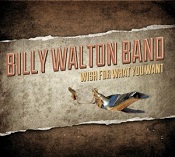 So what’s been happening to the Billy Walton Band since the release of “Crank it Up” in 2012? Well, apart from the non-stop touring in the USA, Europe and the UK, the band has had a few line-up changes. Tenor sax player Rich Taskowitz has moved on and Billy has brought in Ian Gray (trombone) and Sean Marks (tenor and baritone sax) to fill out the band’s sound, moving away from a jazz set-up with two soloists to more conventional rock and soul lineup with frontman and backing horn section. It’s a slight change of emphasis, but it creates a more cohesive full-band sound underpinned by the rock-solid rhythm section of John D’Angelo (drums) and William Paris (bass).
So what’s been happening to the Billy Walton Band since the release of “Crank it Up” in 2012? Well, apart from the non-stop touring in the USA, Europe and the UK, the band has had a few line-up changes. Tenor sax player Rich Taskowitz has moved on and Billy has brought in Ian Gray (trombone) and Sean Marks (tenor and baritone sax) to fill out the band’s sound, moving away from a jazz set-up with two soloists to more conventional rock and soul lineup with frontman and backing horn section. It’s a slight change of emphasis, but it creates a more cohesive full-band sound underpinned by the rock-solid rhythm section of John D’Angelo (drums) and William Paris (bass).
For their fourth studio album, “Wish for What You Want” (released in the USA on Vizztone on January 27), the band has enlisted the services of respected producer Tony Braunagel and keyboard player Mike Finnigan, plus a few special guests from New Jersey and the tweaks seem to have paid off. As you might expect from the Billy Walton Band, the album works across many styles and genres, featuring strong songs and the usual high quality arrangements and playing; oh, and a bit of fun as well.
The album opens in a blast of horns and guitar with the uplifting rock and soul of “Wish for What You Want” and the first of many proper endings – none of your lazy fade-outs here and a standout track. “True Lovin’ Man” has a mid-tempo 70s feel, particularly in the horn arrangements before the blues stomper “Mountain” bursts in with a huge guitar riff. “Come on Up” is an organ-driven straight-ahead rocker, building up a head of steam before changing down a few gears for the country blues of “Blues Comes A Knockin’” featuring Southside Johnny on harmonica. “Forgive and Forget” takes the tempo straight back up again with the full band with organ and horns laying the foundation for Billy’s wah-wah guitar fills and solo. If the album gets a vinyl release, this is the perfect way to end Side One.
“Change” is exactly that, a brooding, atmospheric piece which channels Sergio Leone through Ray Manzarek before breaking into the straightforward blues chugger, “Worried Blues”. The next three tracks are probably the most commercial songs on the album; “Till Tomorrow” is a reworking of a “Crank It Up” song which adds a piano intro and plays down the horn fills. It’s a great song with a perfect guitar hook and in earlier times it would have been a perfect choice for a single. “Walk that Little Girl Home” is a Willy de Ville cover which mixes early Springsteen with The Drifters to evoke the Jersey shore perfectly and create another of the album’s highlights. “It Don’t Matter” has an E Street Band–inspired intro leading in to a “Take Your Job and Shove It” lyric which might or might not be autobiographical; it also features a great sax solo from Joey Stann; another former Asbury Juke. The album’s final track, “Hudson County Star” is loose blues/rock workout poking fun at corruption in the New Jersey political scene (a wide target, to be fair) which gives William Paris his customary shot at a lead vocal.
“Wish for What You Want” is another step forward for the Billy Walton Band. The band has evolved from the original power trio line-up focussing mainly on Billy’s guitar work to a rock and soul five-piece capable of covering a wide variety of styles. If you like your songs served up with big guitars and horns, then this one’s for you. If you decide that you like the album, then I’ve got a piece of advice for you; go out and watch the band live. You won’t regret it.
Released January 27 2015 on Vizztone.
There was a time earlier this year, when I was hobbling around with the help of a crutch, when I thought that I would have difficulty scraping together five gigs that I’d actually seen; how wrong was that? It’s been difficult to narrow this list down to five, so I think there might be a few honourable mentions as well. So, in absolutely no order at all are my favourite live shows of 2014.
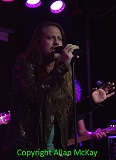 Jim Stapley Band at 93 Feet East
Jim Stapley Band at 93 Feet East
Jim Stapley’s debut album almost made my top five albums, but there was absolutely no doubt about this live performance. Jim has a phenomenal soulful rock voice and he has pulled together a superb band to deliver the songs live. This was an album launch gig featuring virtually all of the album “Long Time Coming” (plus a cheeky cover of Rihanna’s “We Found Love”) and, despite atrocious weather and a half-full venue, Jim and the band gave it everything. The songs were strong, the band were cooking on gas, but what a voice.
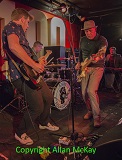 Stone Foundation at The 100 Club
Stone Foundation at The 100 Club
Towards the end of a very busy year for the band, this was an appearance at the annual Delicious Junction bash and another headline slot at The 100 Club with a set based solidly on the “To Find the Spirit”. All of the band members are great players but, despite the solos, this isn’t about individuals, it’s about the group; it’s the perfect combination of a locked-in rhythm section, keyboards and horns. It was also a chance to see how the new members Gareth John (trumpet and flugelhorn) and Rob Newton (congas) had bedded in. It’s fair to say that the horns sounded better than ever and the congas added a little bit of icing on the cake. It was a great set from the band and a stomping encore of “Jumping Jack Flash”. Enough said.
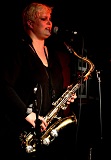 Little Devils at The 100 Club
Little Devils at The 100 Club
Yeah, The 100 Club again and it’s blues Jim, but not as we know it; Little Devils are fronted by singer and multi-instrumentalist (sax and flute), Yoka. The rhythm section of Graeme Wheatley and Sara-Leigh Shaw (aka the Pintsized Powerhouse) built a solid base for Big Ray’s guitar and Yoka’s vocals and instrumental solos. The quality of the playing alone would put this gig up there with the best this year but this is also great fun; the band obviously enjoy themselves and the audience will always pick up on that. Great performances and big smiles all around the room; that’s a pretty good combination for a great night.
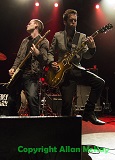 Federal Charm and Ian Hunter’s Rant Band
Federal Charm and Ian Hunter’s Rant Band
This was the final night of the Ian Hunter tour and the audience was in a party mood. It’s not the first time I’ve seen Federal Charm but they seem to get better every time. They got a huge cheer when they strolled on to the Shepherds Bush Empire stage and powered their way through thirty minutes of melodic blues rock featuring their powerful cover of “Reconsider” before making way for Ian Hunter. What a legend; played for two hours and kept the audience spellbound throughout, and the voice still sounds great. We even got an appearance from Mick Ralphs for the encore. Top night.
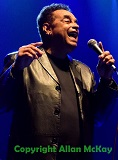 Gary Bonds, Southside Johnny and The Asbury Jukes
Gary Bonds, Southside Johnny and The Asbury Jukes
Now this sounded like a great idea. 60s legend, and big influence on the Asbury Park scene teams up with Southside Johnny for a UK tour; I’ll even pay for tickets for that. Albany Down, despite a ten-second soundcheck, got the audience nicely warmed up for the main event which was a set from Gary Bonds (with some help from Southside) and a set from Southside (with a little help from Gary Bonds), both backed The Asbury Jukes. As ever, the superb musicians (Jeff Kazee, Tom Seguso, John Conte, Glenn Alexander, John Isley, Chris Anderson and Neal Pawley) fitted together perfectly and reacted instantly to any curveballs thrown by Southside. Seriously great players but they know how to have a bit of fun as well. They’re a great attraction as The Jukes, but Gary Bonds just tipped it over the edge.
It was incredibly difficult to narrow this down to only five gigs and there are a few more which deserve honourable mentions. I saw Vera Lynch three times (including their final gig at The Barfly in Camden and a gig in a Shoreditch shop window), The Kennedys and Edwina Hayes at Green Note and Dean Owens and Black Scarr on Eel Pie Island and all of those were great nights. Here’s to many more in 2015.
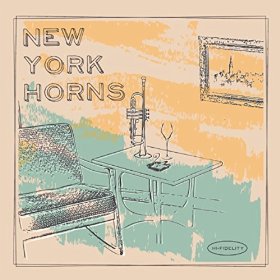 It’s relatively easy to record an album these days; you can do it at home or maybe in a studio and it won’t cost you the earth. You can organise your own distribution online or at live shows; you won’t get rich but you will get some return for your creativity. Not everything released by this route is good; there are way too many vanity projects, but occasionally something really worthwhile emerges. Sometimes a group of talented and like-minded musicians get together and just play the tunes they really want to play. If it makes a few dollars, that’s fine, but that’s not really the point because the musicians are playing the music they want to play and having a bit of fun with their own original material and a few covers. Very, very occasionally the result is an album packed with, superb performances and arrangements that you want to listen to again and again. “New York Horns” is one of those.
It’s relatively easy to record an album these days; you can do it at home or maybe in a studio and it won’t cost you the earth. You can organise your own distribution online or at live shows; you won’t get rich but you will get some return for your creativity. Not everything released by this route is good; there are way too many vanity projects, but occasionally something really worthwhile emerges. Sometimes a group of talented and like-minded musicians get together and just play the tunes they really want to play. If it makes a few dollars, that’s fine, but that’s not really the point because the musicians are playing the music they want to play and having a bit of fun with their own original material and a few covers. Very, very occasionally the result is an album packed with, superb performances and arrangements that you want to listen to again and again. “New York Horns” is one of those.
So, who are the New York Horns? Well the horn players are Chris Anderson (trumpet and flugelhorn), John Isley (tenor and baritone sax and bass clarinet) and Neal Pawley (trombone and vocals) and they’re better known as the horn section of Southside Johnny the Asbury Jukes. Here they’re aided and abetted by fellow-Jukes Jeff Kazee (piano, Hammond B3, keys and vocals) and Glenn Alexander(guitars, dobro, mandolin and vocals) and a rhythm section of Shawn Pelton (drums and percussion) and Tony Tino (electric bass).
The album opens with a very different instrumental take on KT Tunstall’s breakthrough song “Black Horse & the Cherry Tree”. Where the original builds gradually by using a loop pedal for instrumental and vocal parts, the NYH version comes in, after a quick guitar intro, at full strength with Latin American percussion (courtesy of Marc Quinones) and perhaps a hint of early Santana. Chris Anderson’s tone poem “Morningside at Midnight” is next, taken at a walking tempo, and evoking the spirit of Morningside Heights with electric piano, wah-wah guitar and unison sax and trumpet. The Hank Williams classic “Hey Good Lookin’” is the first vocal piece, driven along by a guitar riff and horn fills before the sax, guitar and Hammond solos kick in. “Song for Levon”, a Chris Anderson and John isley co-write is a tribute to Levon Helm. It’s stately and mournful in classic New Orleans tradition and features Southside Johnny as guest harmonica player.
The uptempo jazz-funk of John Isley’s “Little Miss Thing” wouldn’t sound out of place on either of Donald Fagen’s first two solo albums and features the first trombone solo on the album from Neal Pawley; it’s great fun. “Can’t Stand to See You Cry”, written and sung by Jeff Kazee, is a powerful soul song with a superb plaintive vocal and an arrangement that Allen Toussaint would be proud of while “Strollin’ With Sean” is a fairly straightforward blues driven along by a horn riff and it’s another chance for the guys to solo for all they’re worth and have a great time. The final cover on the album is John Hiatt’s “Little Head” which retains the feel of the original while adding punch with horn fills.
John Isley’s “78 Below” opens with an uptempo Nile Rodgers –style lead/rhythm riff which, with the punchy bass, drives the piece along underneath a staccato muted trumpet melody before the mood mellows again with Chris Anderson’s “More Than Tears”. Opening with a restrained combination of piano, acoustic guitar and mandolin, this moody and melancholic piece is perfect for the flugelhorn which Chris uses to carry the main melody. John Isley’s “Under the Hood” is an atmospheric piece using Hammond and the horn ensemble to create the mood and features a muted trumpet solo from Chris Anderson. The album’s closing song, “Nothing Left to Say”, opens slowly in New Orleans jazz funeral style, with a guest vocal by Christine Ohlman before erupting just before the halfway mark into uptempo New Orleans jazz with trumpet and sax counterpoint. There’s also a lyrical message here which underpins the whole album; however bad things get, there’s always music to pull you back, whether you play it or listen to it. It’s a perfect way to close the album.
The beauty of this album is that it was made because the musicians involved really wanted to make it. They had a lot of ideas and they wanted to get those ideas out there to people who might want to hear them. It’s not about focus groups or marketing teams; it’s about strong, sometimes very personal, material arranged well and played superbly. If you need to label it, I suppose it’s jazz, but it also pushes out in other directions as well, towards funk and old school soul; there’s certainly plenty of variety on display. Check out some of the song links here and think seriously about buying yourself a copy, if only to let a bunch of great musicians know that some people out there are actually getting the message.
Available now from Amazon and iTunes.


